Content
The key point in launching an advertising campaign is effective ad copies. You can set up all settings correctly, but the wrong communication strategy can increase the cost per result and cause negative reactions from an audience in relation to your product.
Before you create a communication strategy, you choose the appeal: rational or emotional. It determines how to influence users. Let’s have a look at each approach.
Rational Appeal
Rational adverts affect logical reasoning. With the help of appropriate arguments and detailed information, you justify the benefits of product purchase. Telling about your product using logical arguments, you express your point of view and prove the truth of your comments. That, in turn, activates the attention of users and causes interest in adverts.
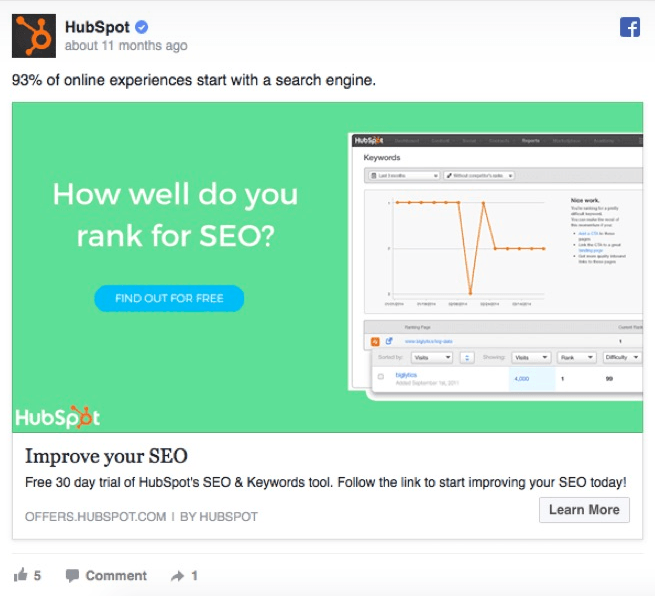
However, this approach may not be suitable for all products, and for branding, especially.
Each theme dictates its own way of communication. For instance, advertising of targeting services will have rational appeal, and advertising of a tour to Bali will have an emotional one.
Emotional Appeal
This approach is based on using emotions and feelings. Emotional communication can resonate with some specific audience’s feelings and thus, it’s able to arouse great interest among an audience.
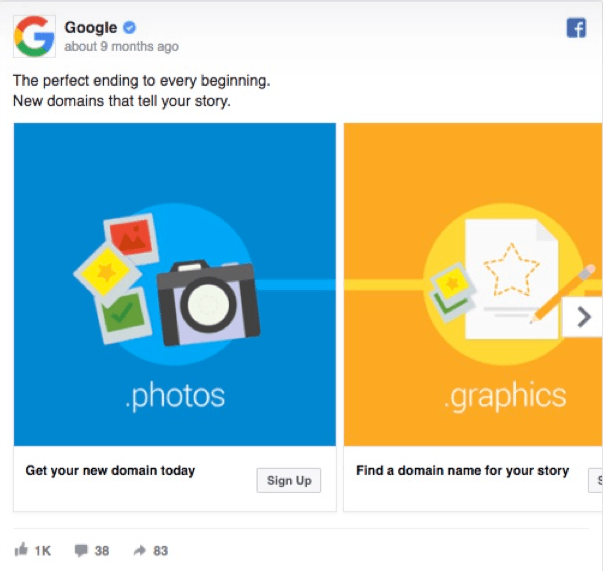
Don’t add logical arguments to an emotional text. For example, a text about a happy childhood can cause certain feelings and associations. However, if you use a rational appeal at the end, it’ll ruin the initial emotional message and “turn off” user’s emotional state.
If the purpose of your text is to provoke certain emotions and owing to them get a planned reaction, you shouldn’t use a rational approach. Rationality always suppresses emotionality but not vice versa. If you use a logical approach in the text, it’s acceptable to add an emotional appeal at the end. Let’s say, you promote some product and highlight its advantages and favorable price. After argumentation, you can add an emotional appeal. If it triggers certain user’s associations or feelings, these emotions will be able to give impetus to conversion.
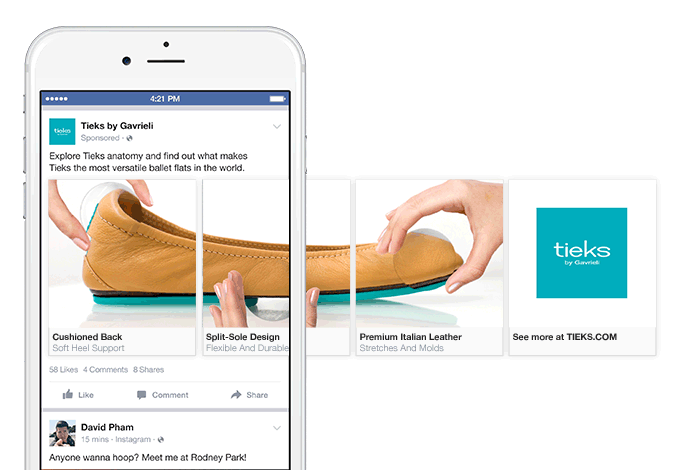
When you decide on how to communicate with your audience, you should turn to transactional analysis and see what position your audience holds.
At the stage of creating a communication strategy, you have to make a transactional analysis and decide which position your audience takes.
What is Transactional Analysis?
Transactional analysis (or TA as it is often called) is the famous ‘parent-adult-child’ theory which was developed by Dr. Eric Bern. The personality structure is characterized by 3 ego states: Child, Adult, and Parent.

Each state has certain behavioral stereotypes and thinking patterns. If you choose Child Ego State, you have to use an emotional approach. If you communicate with the audience using Parent Ego State, then your approach should be based only on logical reasoning. Using Adult Ego State, you can try both approaches: emotional and rational ones.
It’s also important to realize which ego state is yours. It affects the context of your messages and determines your positioning. After all, communicating as a Child, you won’t write abstruse arguments, you’ll speak easily and naturally.
In order to determine the type of approach and needed ego state, it’s important to decide what type of ad campaigns you’re going to run.
Types of Ad Campaigns
There are such types of advertising campaigns as conversion, reach and brand awareness. Let’s have a closer look at creating ad copies for each type.
Conversion Campaign
Obviously, users read a short and concise text better. However, it’s necessary to shorten the text in such a way that your audience will get the picture.
There are 2 ways to check whether the audience understands you or not:
- Before launching an ad campaign.
Select a small group from your target audience and check a text with them. If they understand it, then start launching the campaign. It’s important to test it on the target audience only.
- After launching an ad campaign.
Before driving traffic to the site, install some tracking programs such as Plerdy, Hotjar or Yandex.Metrica. With the help of screen recordings, you can track user behavior on the site. Using heat maps, you’ll understand how they read the information. You set up targeting correctly, but if the message is wrong, you’ll get a high Bounce Rate.
It’s important to add CTA in conversion campaigns.
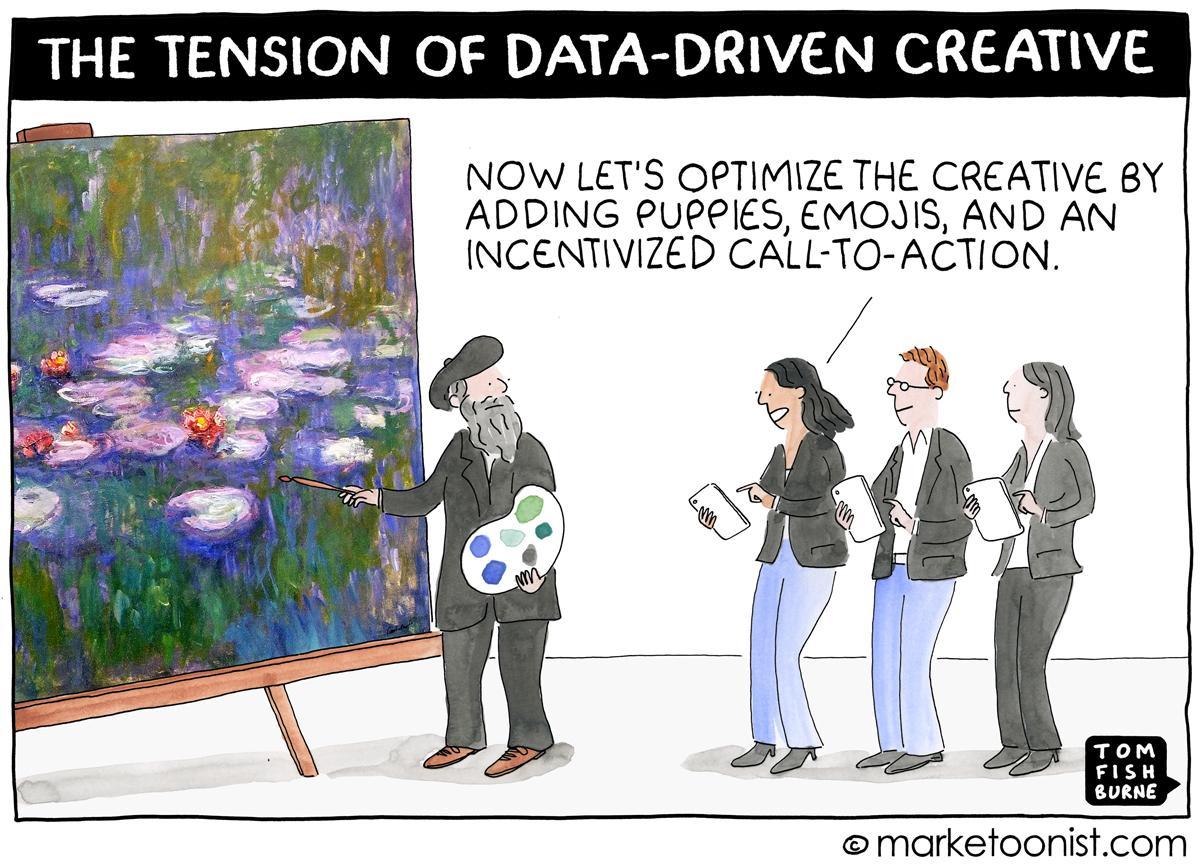
A CTA (call-to-action) is a kind of instruction for users and without it any of your conversion campaigns shouldn’t run.
Using a CTA, you create the idea that they need to take a targeted action: buy, download, register, etc. Without a CTA, your advert turns into a regular informational leaflet.
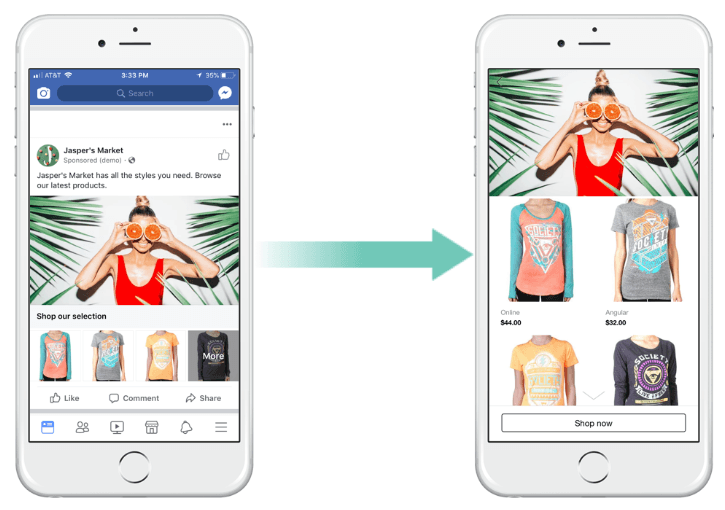
Reach and Brand Awareness Campaigns
These types of campaigns don’t imply the achieving of a specific goal such as sales, installation of a mobile application, etc.
The purpose of the reach campaign is to inform the audience about the brand, the product, its benefits, changes in the company, the new product launch, etc. Brand awareness campaign forms a certain status association.
For example, the water delivery company “Aqua” has released a new product which is water with lemon flavor. In this case, we need to launch the reach campaign in order to inform an audience about the new product. If the company was certified or won a competition, it is worthwhile to launch the brand awareness campaign and form an appropriate conclusion in the mind of the target audience.
Targeting settings for these campaigns are the same. The key point is communication. By controlling the reach and frequency of impressions, we should try reaching the entire audience as much as possible, but at the same time avoiding ad fatigue.
Brand awareness campaigns use an emotional approach in most cases. Reach campaigns use emotional and rational approaches. While a person feels some emotions, new neural pathways are being created. However, a rational appeal can trigger only existing ones.
We have to feel emotions in order to have some memories or associations. Thus, it is the formula for branding: causing certain emotions, you are “programming” the audience for the associations you need.
Consequently, in reach and brand awareness campaigns, create slogans, not a CTA.
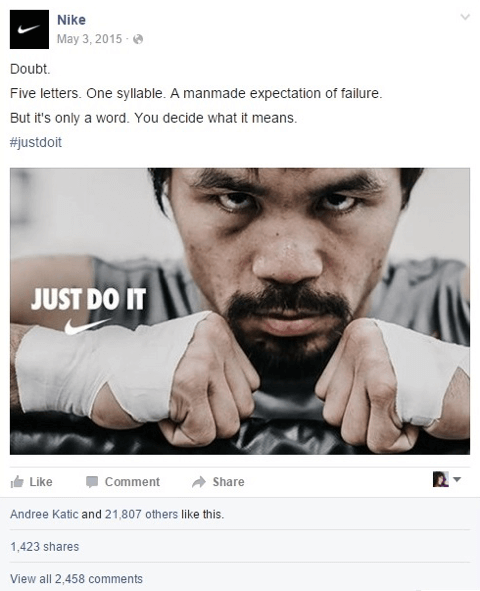
We have analyzed types of campaigns and approaches. Let’s choose an ad format.
Ad Formats
Vertical and square formats work best. When you are scrolling through a mobile news feed, it’s more complicated to go past such formats since they take up more space. Accordingly, it’s more likely to attract the user’s attention.

The choice of an ad format depends on:
1. Customer Journey stage.
When an audience visits the site and the mobile app, they start moving to the target action and creating specific User Flows. However, not all users reach the final target action. Therefore, if you understand at what stage user is and use retargeting, you can select the right format for communication.
For example, if a user visits pages with sale offers but didn’t look at a specific product, we choose “Carousel” or “Collection” formats in order to show them the products with the best prices. If the user chooses a particular product, we use “Slideshow”, “Picture” or “Video” formats. In the case of the purchase, the next step is cross-sell. Then “Slideshow”, “Picture” or “Video” formats are suitable as well.
2. Target group at the acquisition stage.
Every buyer persona may perceive a particular format in different ways. It’s extremely important to understand who your audience is and how they respond at the acquisition stage. If they are emotional or your product causes certain emotions, use “Video” or “Slideshow” formats. They help to engage users.
For complex products that require a detailed explanation of how it works, use “Video” or “Slideshow” formats as well. If you need to bring information in a logical way so that your audience can make a decision, just use the “Picture” format.
Video is the leading format
If we exclude the target audience characteristics and the Customer Journey stages and see the benchmarks, then the video format has the highest engagement indicator. The video helps to reveal your idea and involve the user more effectively than a static banner. However, it is important not to misuse this format at each of the stages of the funnel, because you can make a user tired.
The brain processes a video 60,000 times faster than a text. A video activates other parts of the brain and as a result, people react to it based on what they see. In the case of a static picture, a person can “turn on the filter” and ignore it. The video can change the user’s initial reaction, but the picture is not capable of doing it.
Nielsen data shows that 47% of ad recall happens in the first 3 seconds of a video ad and 74% in the first 10 seconds. This is a good opportunity for advertisers to raise awareness and influence the consumers’ decision regarding the purchase, even if they see only the beginning of a video ad.
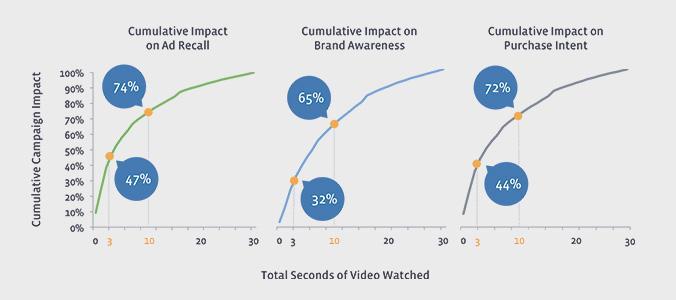
- Results of Nielsen’s research
The video creation platform Promo conducted a survey that showed that 71% of users call Facebook video ads as “relevant” or “highly relevant”.

We all watch videos either at work, at home or using public transport. We don’t frequently have the opportunity to watch videos with sound. You, as an advertiser, should definitely take this into account when creating video content. The video should convey the idea without sound, so add subtitles and create clear messages that will be understood by a viewer even without sound.
Optimum video length
Facebook recommends creating a video of up to 15 seconds. In case, you need to convey your idea, don’t limit yourself — create a video up to 30 seconds. If you need to tell a story — feel free to extend your video up to a minute. Only a few users will look until the end of the video, but you can track that if the average percentage of views is growing, then your creative is relevant. Otherwise, shorten the video or change the whole idea.
Transactional analysis is ready. The type of campaign and ad formats are chosen. Next, let’s create communication.
Selection of creatives
The primary task of an ad copy is to engage users and get their attention.
Creation of Creatives at Acquisition Stage
At the acquisition stage, we create ad copies, according to the insights. Insights help to understand why people buy a particular product, why they need particular services or what motivates them to take targeted action. Therefore, you don’t have only to describe a product because people can read about its properties on the site.
Focus on consumers’ needs which your product can solve. A product not only can solve the problem but also provide opportunities. For instance, a balloon flight isn’t a “problem-solving” service. However, during a flight, you can receive a lot of emotions and gain some experience. In the target group “Extreme lovers”, the insight is a desire to get adrenaline and new emotions. In this case, communication will be based only on an emotional approach.
The target group “Insta-bloggers” may have a fear of heights. Although, for the sake of topnotch content they will be ready to deal with fear. In such a case, you can use both emotional and rational appeals. The insight for this target group is that they are always in pursuit of high-quality content that will help them increase the Engagement Rate or get targeted actions. Despite the fact that they cannot get any positive emotions during a balloon flight, they will realize that this can bring them new followers, interactions, etc. So, you need to form communication using both approaches and start testing for understanding which a target group prevails.
How to identify insights?
Insights can be powerful, but how do you find them? Don’t look for insights. Get to know them in your audience. Analyze reviews, study their behavior, communicate and ask them questions. When you realize their real needs, you’ll understand what drives them in the decision-making process. However, be careful that not every answer can be the truth.
For instance, Jane told everyone that she starts studying in Great Britain English courses because she likes their an individual approach to each student. Also, they are the best in preparing students for the IELTS test. However, this is the school where her best friend works as a teacher, actually. After receiving the answers, you should always validate them in order to understand real reasons.
How to create insights?
We use such methods as Jobs-to-be-done (JBTD), Customer Development, and the Creative Matrix, developed by our team.
Creative Matrix
We developed the Creative Matrix for testing different insights and developing behavioral factors of the audience. We form insights on the basis of both emotional and rational appeals.
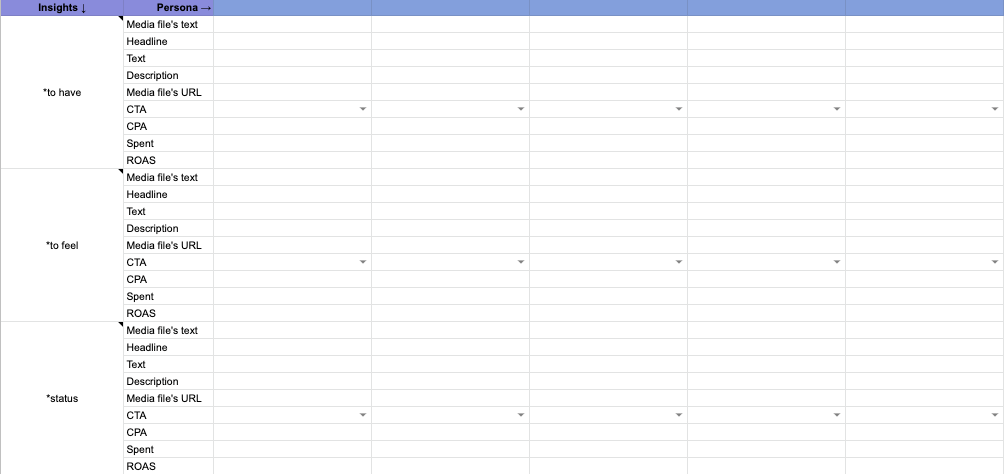
The sheet presents standard insights. However, each project has its relevant insights. For example, one of the reasons why people play games is an interesting scenario. In order to interest game lovers, you have to tell in an ad copy what a scenario is waiting for them.
Insights should be created and tested separately for each target group. Your transactional analysis forms the tone of communication with the target audience.
► Create a list of your insights on your project vertically.
► Write your target groups horizontally.
► Create relevant text for each target group according to insights.
Therefore, you not only can test just the objects of the ad copies (picture, button, etc.) but also find insight that you will be able to use for maximizing the audience’s desire to perform the target action. The right message determines the cost per result which can change the efficiency radically.
Creation of Creatives at Retention Stage
Warm and hot audiences are not tested for finding insights. For retargeting, we create messages based on the user’s behavior on the site, in the mobile application and at the funnel stage. For instance, a change of communication for tour booking on the site would look like this:
⇨ For site visitors who haven’t watched a particular tour: “Check the Lowest Prices on Top Destinations!”
⇨ For visitors who moved through the funnel and watched a specific tour: “Visit Amsterdam in May — Best Price Booking Online!”
⇨ Visitors who chose a tour but didn’t purchase it for some reason: “Hurry! Only 2 Free Spots Left on Special Prices”
Benefits of Personalized Retargeted Ads
Due to Facebook Pixel, you can get information about which product your audience is interested in. For example, knowing that a user is interested only in new models of iPhone, offer him it exactly after the new release. With the help of pixel parameters and variables, you can see segments of your audience that are interested only in a certain amount of phone’s capacity, color or other criteria. It allows to deliver the most relevant offer to each segment of the audience and get the maximum amount of responses, which can increase sales significantly.
Substitution of communication in eCommerce
Let’s look at the substitution of communication in eCommerce. The following graph shows the funnel stages and days of the user’s decision-making process.

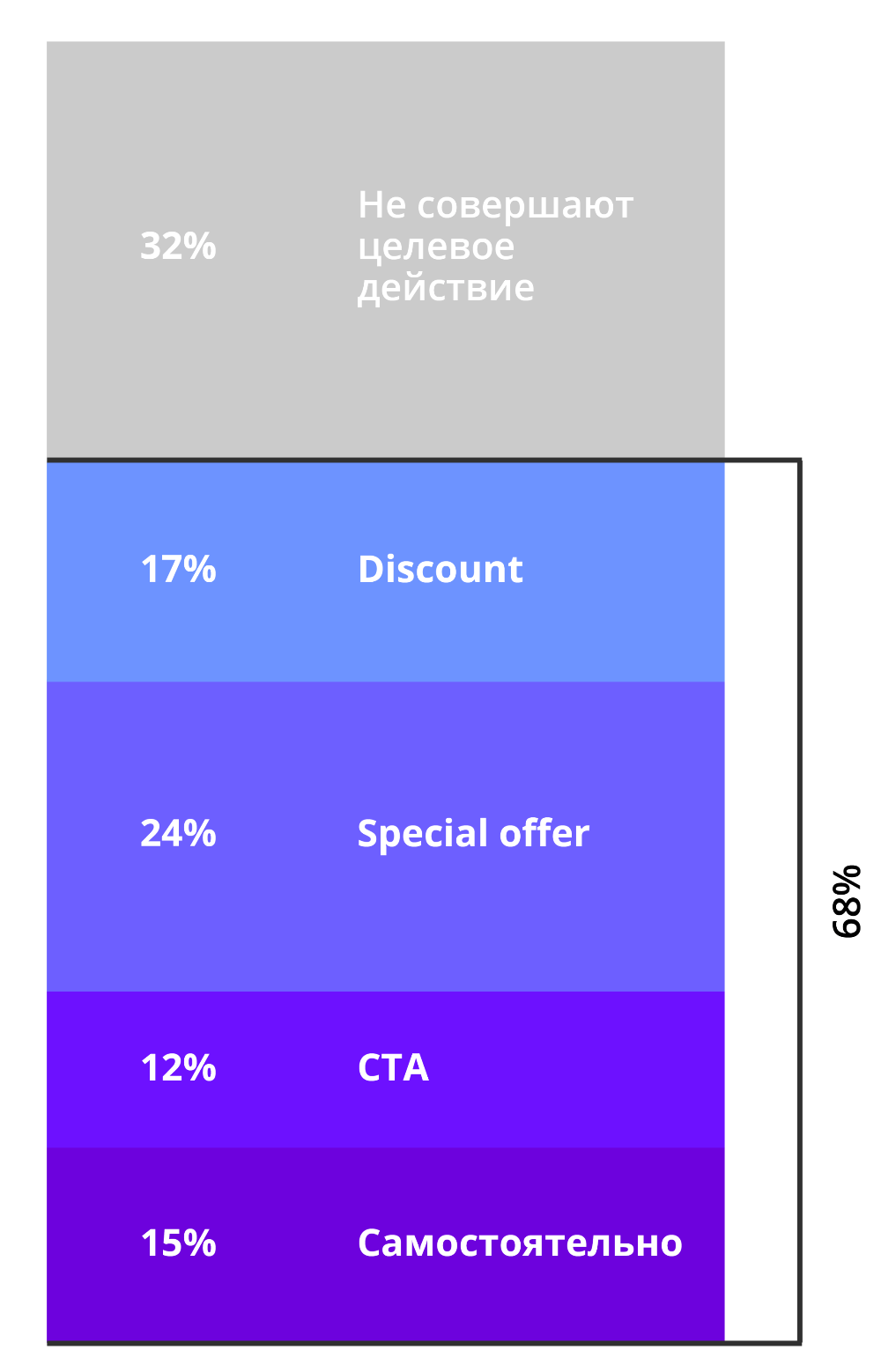
There is a part of users that goes through all the stages of the funnel on their own and performs the desired action. Let’s imagine that this is about 15% of the entire audience. By launching an ad campaign for n days, we can convince another part of the audience to perform the desired auction.
For the rest of the audience who didn’t respond to the call to action (CTA), we prepare a special offer. It may be interesting for them and they may react to it.
There is also an audience that is not ready to make a purchase and not interested in your product at all. In this case, we offer a discount. On the one hand, it’s kind of a loss for the business. On the other hand, it helps attract users and to earn at the same time. There will also be a certain percentage of the audience who won’t do the desired action at all.
The communication scenario may change, since we showed the one option: for example, that ads with call-to-action can only attract part of the audience. To engage the rest, you need to interest them in other ways.
To get more results, you don’t need to increase the budget or the duration of an ad campaign. Change your communication in order to convince less motivated users.
Technical Requirements for Creatives Design
It’s important to consider all technical requirements from Facebook and customize each creative according to placement. Be sure to check the type of ad copies in all placements and send them for preview to your mobile phone.
Make sure the text and banners are readable. Always check the amount of text using the Image Text Check tool. Facebook’s guide includes a 20% text rule, meaning that a text on ad photos cannot take up more than 20% of the photo. The one reason to do it is increasing of the cost of the result due to an excessive amount of a text. Moreover, it distracts users while the initial purpose is drawing their attention.
Test different formats, but note that square or vertical creatives work more effectively. You can find requirements and specifications for all placements in the Facebook Ads Guide.
Key Metrics for Tracking Performance of Ad Copies
► Bounce Rate. High Bounce Rate shows you that there is no connection between appeals in creatives appeal and texts on the site. Thus, you confuse users who visit your site after clicking on an ad.
► Low CTR indicates that you chose weak communication which doesn’t influence the audience well enough.
► High CTR and low CR mean that the communication strategy is the right one, but there are problems with texts on the website or in the mobile app.
High CTR and CR? It’s time to move on to scaling!
To Sum Up
- First of all, use transactional analysis to validate the tone of your communication.
- Choose the right approach: emotional or rational. Don’t add logical arguments to messages which have an emotional appeal. However, it is fine to use an emotional appeal after rational arguments.
- The important task is to find the right communication. It determines the cost per result. Targeting settings, testing creative objects, and other settings only correlate the cost per result.
- Consider the type of ad campaign. It’s almost impossible to create an idea of a brand using a rational approach.
- Design creatives based on insights and people at the acquisition stage.
- Design creatives based on user behavior at the retargeting stage.
- Focus on the video format but also test other ones.
- Take into account the technical requirements. Check your creatives before an ad campaign starts to run.
- Track how much your audience understands an idea of your messages with the help of these metrics: Bounce Rate, CTR, CR.
If you like our article, share it with friends. 🙂
Subscribe to our Messenger bot and Telegram channel to receive the most useful content about advertising on social networks!
If you have found a spelling error, please, notify us by selecting that text and pressing Ctrl+Enter.












